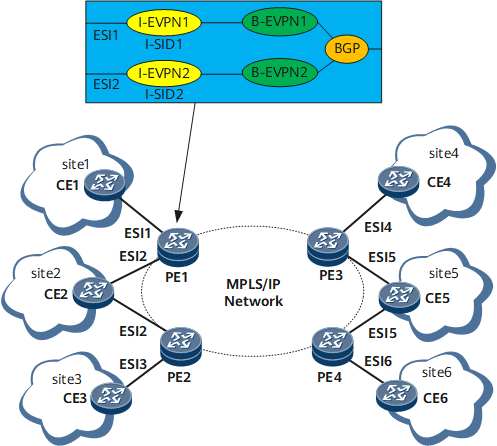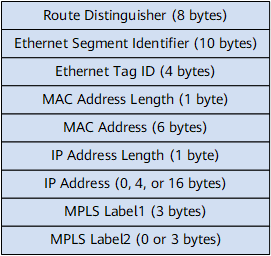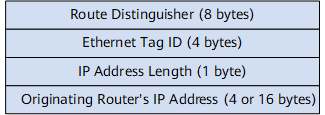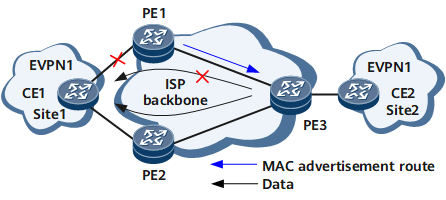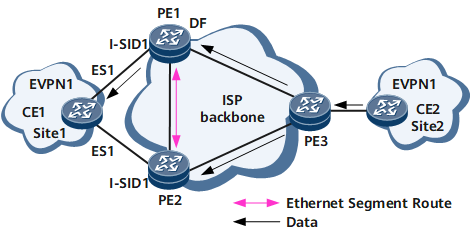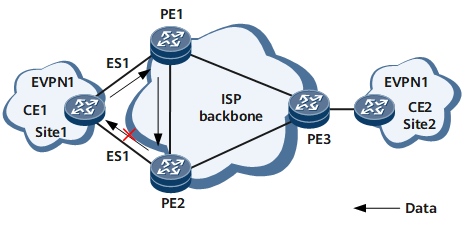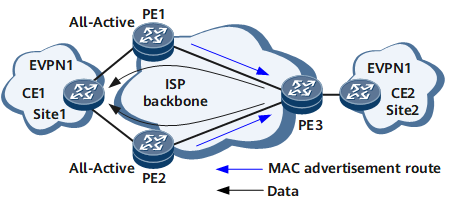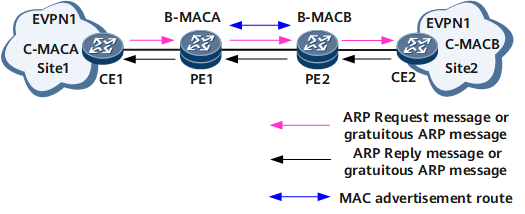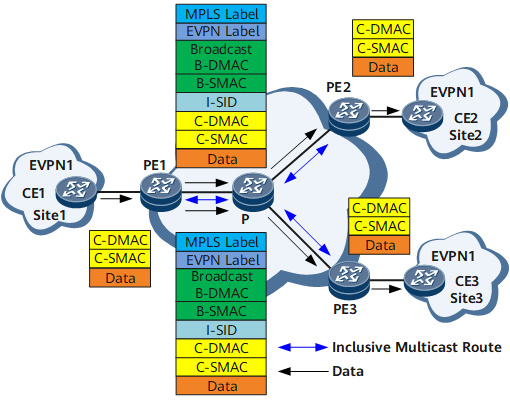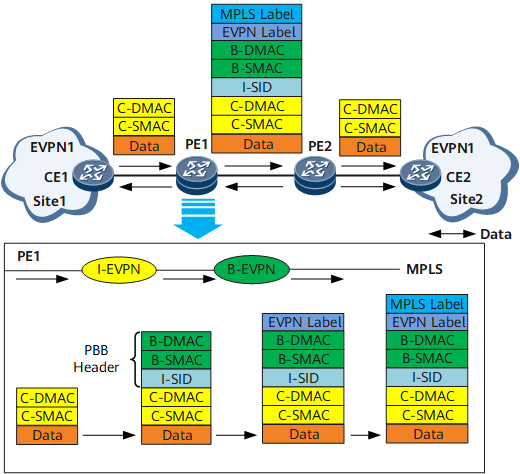PBB-EVPN Fundamentals
PBB-EVPN Networking
PBB-EVPN is an L2VPN technology implemented based on MPLS and Ethernet technologies. PBB-EVPN uses BGP to exchange MAC address information between PEs on the control plane and controls the exchange of data packets among different sites across the MPLS network.
PBB: a technique defined in IEEE 802.1ah. PBB precedes C-MAC addresses with B-MAC addresses in a packet to completely separate the user network from the carrier network. This implementation enhances network stability and eases the pressure on the capacity of PEs' MAC forwarding tables.
I-EVPN: accesses the user network by being bound to a PE interface connecting to a CE. After an I-EVPN instance receives a data packet from the user network, the I-EVPN instance encapsulates a PBB header into the packet.
B-EVPN: accesses the backbone network. A B-EVPN instance manages EVPN routes received from other PEs.
I-SID: uniquely identifies a broadcast domain. One I-EVPN instance corresponds to one I-SID. If two PEs share the same I-SID, the two PEs belong to the same BUM group.
Table 1 describes the key points in PBB-EVPN implementation.
Plane |
Key Points in Implementation |
Related Concepts |
|---|---|---|
Control plane |
PEs use BGP to exchange PBB-EVPN routes and use the B-MAC addresses learned from these routes for later data packet transmission. |
Related PBB-EVPN routes:
|
PBB-EVPN supports fast convergence. |
||
On a multi-homing network, PBB-EVPN uses DF election to prevent bandwidth waste. |
||
PBB-EVPN uses split horizon to prevent routing loops. |
||
On a multi-homing network, PBB-EVPN supports load balancing. Currently, PBB-EVPN supports only per-flow load balancing, and does not support VLAN-based (per-ISID) load balancing. |
||
Data plane |
PBB-EVPN supports the transmission of unicast and BUM packets. |
|
PBB-EVPN Routes
MAC advertisement route: carries B-EVPN instance RD, B-MAC address, and VPN label information on the local PE. Figure 2 shows the prefix format of a MAC advertisement route packet. A PE uses MAC advertisement routes to advertise B-MAC address reachability information to other PEs. When network topology changes due to a CE node failure or CE-PE link failure, the corresponding PE sends MAC advertisement routes to instruct other PEs to refresh C-MAC addresses corresponding to the specified B-MAC address, thereby achieving fast convergence.
The description of each field is as follows:Route Distinguisher: a field representing the RD of an EVPN instance.
Ethernet Segment Identifier: a field of all 0s or Fs. In a dual-homing single-active scenario, the value is all 0s. In a dual-homing active-active scenario, the value is all Fs.
Ethernet Tag ID: a field of all 0s for MAC advertisement routes.
MAC Address Length: a field representing the length of the MAC address advertised by the route.
MAC Address: a field representing the MAC address advertised by the route.
IP Address Length: a reserved field.
IP Address: a reserved field.
MPLS Label1: a field that carries the ESI label.
MPLS Label2: a reserved field.
Inclusive multicast route: carries the EVPN instance RD and I-SID information and source IP address (loopback interface address) on the local PE. PEs exchange inclusive multicast routes after establishing an EVPN BGP peer relationship. Figure 3 shows the prefix format of an inclusive multicast route packet. PBB-EVPN involves BUM traffic. A PE forwards the BUM traffic that it receives to other PEs in P2MP mode. BUM traffic can be transmitted over MP2P or P2P tunnels established over inclusive multicast routes.
The description of each field is as follows:Route Distinguisher: a field representing the RD of an EVPN instance.
Ethernet Tag ID: a field representing the I-SID.
IP Address Length: a field representing the length of the source IP address configured on the local PE.
Originating Router's IP Address: a field representing the source IP address configured on the local PE.

Currently, the EVPN source address on the PE supports only IPv4. Therefore, the field contains only 4 bytes.
Ethernet segment route: carries the EVPN instance RD and ESI information and source IP address on the local PE. PEs connecting to the same CE use Ethernet segment routes to discover each other. Ethernet segment routes are used in DF election. Figure 4 shows the prefix format of an Ethernet segment route packet.
The description of each field is as follows:Route Distinguisher: a field representing a combination of the source IP address on the local PE and :0, such as X.X.X.X:0.
Ethernet Segment Identifier: a field that uniquely identifies links between PEs and CEs.
IP Address Length: a field representing the length of the source IP address configured on the local PE.
Originating Router's IP Address: a field representing the source IP address configured on the local PE.

Currently, the EVPN source address on the PE supports only IPv4. Therefore, the field contains only 4 bytes.
Other Concepts
-
On the network shown in Figure 5, if the link between CE1 and PE1 fails, PE1 will send a MAC advertisement route that carries the MAC mobility extended community attribute to PE3, notifying PE3 that C-MAC addresses at Site1 are unreachable. Upon receipt of the route, PE3 sends traffic to Site1 only through PE2, implementing fast convergence.
-
On the network shown in Figure 6, CE1 is dual-homed to PE1 and PE2, and CE2 sends BUM traffic to PE1 and PE2. In this scenario, CE1 receives the same copy of traffic from both PE1 and PE2, wasting network resources. To solve this problem, EVPN elects one PE as the DF to forward BUM traffic. If PE1 is elected, it becomes the primary DF, with PE2 functioning as the backup DF. The primary DF forwards BUM traffic from CE2 to CE1.
If a PE interface connecting to a CE goes Down, the PE functions as a backup DF. If a PE interface connecting to a CE goes Up, the PE and other PEs with Up interfaces elect a primary DF using the following procedure:The PEs establish EVPN BGP peer relationships with each other and then exchange Ethernet segment routes.
Upon receipt of the Ethernet segment routes, each PE generates a multi-homing PE list based on the ESIs carried in these routes. Each multi-homing PE list contains information about all PEs connecting to the same CE.
Each PE then sequences the PEs in each multi-homing PE list based on the source IP addresses carried in Ethernet segment routes. The PEs are numbered from 0.
The primary DF is elected based on I-SIDs. Specifically, PBB-EVPN uses the formula of "I-SID modulo Number of PEs in the PE list corresponding to the I-SID" to calculate a number and then elects the PE with the same number as the calculated one as the primary DF.
-
On the network shown in Figure 7, CE1 is dual-homed to PE1 and PE2. If PE1 and PE2 have established an EVPN BGP peer relationship with each other, after PE1 receives BUM traffic from CE1, it forwards the BUM traffic to PE2. If PE2 forwards BUM traffic to CE1, a loop will occur. To prevent this problem, EVPN uses split horizon. After PE1 forwards the BUM traffic to PE2, PE2 checks the B-SMAC address carried in the traffic. If the B-SMAC address equals the B-MAC address configured on PE2, PE2 drops the traffic, preventing a routing loop.
-
If a CE is multi-homed to several PEs, a redundancy mode can be configured to specify the redundancy mode of PEs connecting to the same CE. The redundancy mode determines whether load balancing is implemented for unicast traffic in CE multi-homing scenarios. On the network shown in Figure 8, if PE1 and PE2 are both configured to work in All-Active mode, after PE1 and PE2 send MAC advertisement routes carrying the same B-MAC address to PE3, PE3 sends unicast traffic destined for CE1 to both PE1 and PE2 in load balancing mode.
Unicast MAC Address Advertisement
Site1 sends an ARP request or gratuitous packet that carries Site1's C-MAC address C-MAC A and the corresponding IP address to Site2.
Upon receipt of the packet, Site2 returns an ARP reply or gratuitous packet that carries Site2's C-MAC address C-MAC B and the corresponding IP address to Site1.
PE1 and PE2 exchange MAC advertisement routes that carry B-MAC addresses, next hops, and EVPN instance extended community attributes (such as RTs).
PE1 and PE2 construct B-EVPN instance forwarding entries based on the RTs carried in received MAC advertisement routes.
BUM Packet Transmission
CE1 sends BUM packets to PE1.
Upon receipt of the packets, PE1 searches its C-MAC address table for the C-DMAC address carried in packets. If the C-DMAC address cannot be found, PE1 sends the BUM packets to all other PEs in the same redundancy group. Specifically, PE1 replicates a copy of received BUM packets, encapsulates the PBB header, public tunnel label, and VPN label into each copy, and sends the two copies of traffic to remote PEs, respectively. The B-DMAC address carried in the PBB header is a broadcast MAC address.
Upon receipt of the BUM packets, PE2 and PE3 decapsulate the BUM packets and send the BUM packets to the sites identified by the EVPN label carried in the packets.

Use the network shown in Figure 8 as an example. If PE1 and PE2 both work in Single-Active mode, the bidirectional BUM traffic between CE2 and CE1 will be dropped by the backup DF. If PE1 and PE2 both work in All-Active mode, only the BUM traffic from CE2 to CE1 will be dropped by the backup DF.
Unicast packet transmission
CE1 forwards unicast packets that carry the source C-MAC (C-SMAC) and destination C-MAC (C-DMAC) addresses to PE1 at Layer 2.
Upon receipt of the packets, the I-EVPN instance on PE1 searches its C-MAC address table for a matching forwarding entry based on the destination C-MAC address in these packets. After finding such an entry, PE1 encapsulates a PBB header, a public network MPLS tunnel label, and a VPN label into these packets and forwards these packets to PE2. The PBB header carries the I-SID and B-SMAC address configured in the I-EVPN instance and the B-DMAC address obtained from the C-DMAC address table.
Upon receipt of these packets, PE2 removes the tunnel label and PBB header, searches the local C-MAC address table for a matching forwarding entry, and forwards these packets to an outbound interface.
